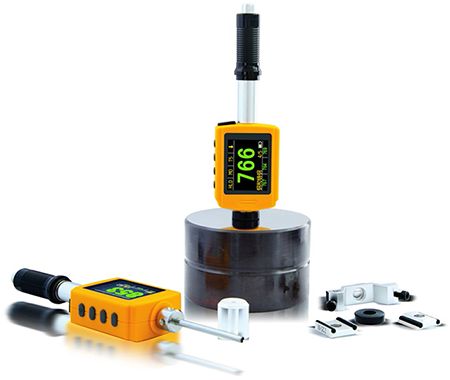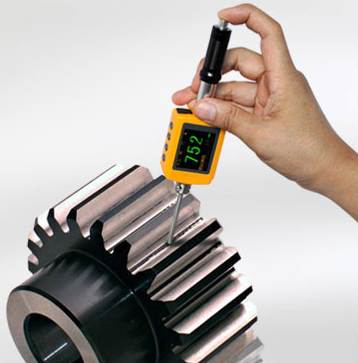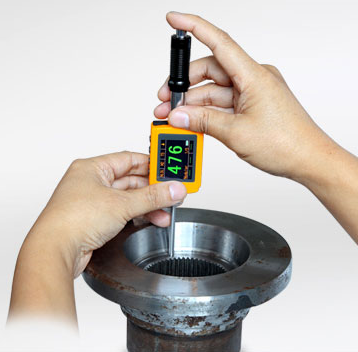The DLH-330 is the new, improved version of the DLH-300
The DLH-330 is a pen type design, self-contained (Impact device display integrated) hardness tester, which means no cables and increased portability. It offers a unique 1.77" large-screen OLED color display and is easy to operate with 4 soft keys above the screen achieve various functions. Interchangeable D impact device (standard) / DL impact device (optional) can be used for a dual purpose unit; it can also be used in restricted area measurements such as gear roots. Highly accurate (±6HLD) in any impact direction 360° and automatically identifies impact direction and gravity compensation.



A spring in the probe projects the tungsten carbide ball tipped indenter at the test piece. Impact velocity is measured immediately prior to impact and then on rebound. The quotient is computed and displayed as the Leeb Hardness Value. On hard materials, the rebound velocity will be higher than that from softer materials, which will absorb more of the impact energy.
For a correct and repeatable measurement, certain conditions must be met:
The test piece surface needs preparation by filing, sanding or grinding. As a general rule, if you drag your thumbnail across the surface and it drags, the surface is too rough.
Materials such as cast iron, that have a coarse (large) grain structure, will cause inconsistent measurements. The use of a much large indenter "G" probe will often correct for this condition.
Test parts that have a low mass or thickness need to be supported to prevent movement or deflection.
Selection of the material corrects for material type. The following materials can be selected: Steel / Cast Steel, Gray Cast Iron, Nodular Cast Iron, Cast Aluminum, Brass, Bronze, Copper, Stainless Steel, Forged Steel and Tool Steel*
*Leeb measurements are affected by the material elasticity. To a large degree this is taken care of by selecting the most similar material type from the Material list. If you find that your measurements are a bit high or low, it is because the built-in correction factor does not match your material. You can try a different material to see if this gets you closer to a correct measurement. You can also use a known hardness sample of your test material (having enough mass and thickness) to determine the +/- error and then adjust the reading to match using the Calibration facility.
Set; Up, Down, Sideways, 45° up or 45° down
| Display | 1.77 inch OLED with resolution 160*128 pixels |
| Hardness Scale | HL, HB, HRB, HRC, HV, HS, Strength (σb) |
| Measuring Range | HLD (200-960), HRC (19.8-68.5), HRB (13.5-100), HB (30-651), HV (80-976), HS (26.4-99.5), σb (375-2639) |
| Impact Devices | D type impact device (Standard); Interchangeable DL type impact device (Optional) |
| Accuracy | Measuring Error:±6HLD (HLD=800), Repeatability:±6HLD (HLD=800) |
| Measuring Direction |
360 degree |
| Material | Steel & Cast Steel, Stainless Steel, GC IRON, NC IRON, Cast Aluminum alloy, Copper-zinc alloy, Copper-tin alloy, Brass, Forged Steel, Alloy Tool Steel |
| Resolution | 1HL, 1HV, 1HB, 0.1HRB, 0.1HRC, 0.1HS |
| Calibration | Automatic |
| Language | Multiple languages |
| Power | Lithium battery (Capacity of 600 MA/H, voltage: 3.7 V) or Alkaline battery |
| Data Memory | 1000 groups (each group includes 2-6 testing values and 1 average value) |
| Communication | USB 2.0, Used for charging or data transfer |
| Software | LMView software for transmission, storage and printing |
| Shut-off | Auto off after 3 minutes of inactivity |
| Temperature | -10℃~ +50℃ |
| Net Weight | 110g with Dtype impact device, 125g with DL type impact device |